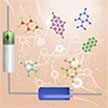| Jan 13, 2022 |
|
|
|
(Nanowerk Spotlight) With the sudden growth of electric vehicles in recent years, there is a need for energy storage systems that are sustainable, economically viable, and lightweight. The lithium-ion battery (LIB) has been offered as a feasible long-term alternative, although supercapacitors and supercapacitor-battery hybrid systems have also been considered.
|
|
Electrode materials with high surface-to-mass ratios are greatly coveted in the drive for lighter and smaller energy storage devices. Two-dimensional (2D) materials are ideal fit for such requirements. Since the successful exfoliation of graphene, such automatically thin materials have attracted tremendous interest in this field.
|
|
However, the 2D material space is massive, and despite recent efforts (both experimental and theoretical), only a small fraction of it has been explored. The limited choice has hindered the promising application of 2D materials in energy storage devices. |
|
In this work (Cell Reports Physical Science, “High-throughput assessment of two-dimensional electrode materials for energy storage devices”), we report a fully automated, first-principles-based computational framework, which can assess the energy storage capacity of thousands of two-dimensional materials in a high-throughput fashion.
|
 |
| High-throughput computational pipeline for discovery of two-dimensional electrode materials for energy storage devices. (Reprinted under Creative Commons CC-BY-NC-ND license from Elsevier) (click on image to enlarge)
|
|
A realistic estimation of maximum Li-ion storage capacity in any material requires a global-minima-search, which is computationally hard and expensive. Such calculations may be conducted for few materials but not for hundreds and thousands.
|
|
We devise four easy-to-calculate descriptors to simplify this problem. These descriptors not only enable rapid screening of materials but also provide important chemical insights (e.g., volumetric change of the electrode during charge and discharge).
|
|
A clear range of values for these descriptors were empirically determined that helps in finding potential materials with high specific capacity.
|
|
The proposed methodology combines explicit-ion and implicit-solvent formalisms to assess a material’s potential for both LIB and supercapacitors, making it useful for a supercapacitor-battery hybrid system, which has been proposed as a viable solution for electric vehicles.
|
|
While the explicit-ion calculation involves the application of conventional density functional theory we adopt advanced joint-density functional theory to model the electrode-electrolyte system. A reactivity test with commercial electrolytes is further performed for wet experiments.
|
|
Leveraging the big-data generated by the computational pipeline, we train crystal graph-based machine learning models and demonstrate how this data-driven model could be helpful for the rapid discovery of potential materials from other databases.
|
|
Our holistic approach, which predicts both Li-ion storage and supercapacitive properties and hence identifies various important electrode materials that are common to both devices, may pave the way for next-generation energy storage systems.
|
|
By Professor Santanu Mahapatra, Nano-Scale Device Research Laboratory, Department of Electronic Systems Engineering, Indian Institute of Science Bangalore
|
|
|


